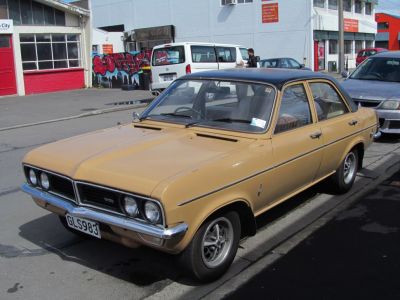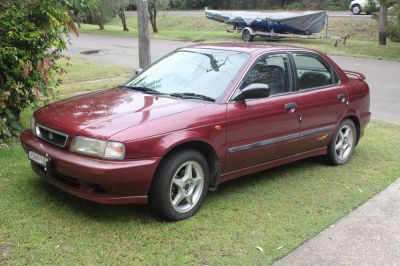 1983 Mitsubishi Lancer III Dimensions, Size & Specs
1983 Mitsubishi Lancer III Dimensions, Size & SpecsMeasurements of the 1983 Mitsubishi Lancer III, engineered for optimal performance and comfort
| Dimensions | |
|---|---|
| Length: | 4125 mm162.4 in13.5 ft |
| Width: | 1635 mm64.4 in5.4 ft |
| Height: | 1360 mm53.5 in4.5 ft |
| Weight Specifications | |
| Curb Weight: | 835-930 kg1841-2050 lbs |
| Maximal permitted Weight: | 1340-1400 kg2954-3086 lbs |
| Tire Specifications | |
| Rims Size: | 13-inch rims:
|
The Mitsubishi Lancer III, produced between 1983 and 1988, is a compact sedan that exemplifies efficient design and practical dimensions typical of early 1980s Japanese vehicles. Measuring 4125 mm (162.2 inches) in length, 1635 mm (64.4 inches) in width, and standing 1360 mm (53.5 inches) tall, it fits well within the compact car category, offering maneuverability and ease of urban driving. The vehicle's curb weight ranges from 835 to 930 kg (1841 to 2050 lbs), depending on the specific configuration, while the maximum permissible weight varies between 1340 and 1400 kg (2954 to 3086 lbs), reinforcing its light and efficient construction. The Lancer III rides on 5J x 13 inch rims, standard for compact sedans of its time, providing a balance of comfort and road grip. This generation of Lancer was produced during a period of growing popularity for compact sedans, focused on reliability and fuel efficiency. Its dimensions and weight make it a practical choice for drivers seeking a small, economical, and manageable sedan that carries Mitsubishi’s reputation for durability. Overall, the Mitsubishi Lancer III remains a notable model for enthusiasts of classic Japanese compact cars and represents a foundational era in Lancer’s long production history.
Discover the standout features that make the 1983 Mitsubishi Lancer III a leader in its class
Have a question? Please check our knowledgebase first.
The Mitsubishi Lancer III sedan, produced from 1983 to 1988, has a length of approximately 4125 mm (162.2 inches), a width of 1635 mm (64.4 inches), and a height of 1360 mm (53.5 inches). These compact dimensions make it suitable for urban driving and easier parking in tighter spaces compared to larger sedans of its era.
The Mitsubishi Lancer III's curb weight ranges between 835 and 930 kilograms (1841 to 2050 pounds), depending on the specific trim and equipment. Its maximum gross weight, which includes passengers and cargo, ranges from 1340 to 1400 kilograms (2954 to 3086 pounds). This relatively light weight contributes to the car's nimble handling and fuel efficiency.
With a length of 4125 mm (162.2 inches) and width of 1635 mm (64.4 inches), the Mitsubishi Lancer III comfortably fits within a standard home garage. Typical residential garages are about 6 meters (236 inches) in length and 3 meters (118 inches) in width, so the compact size of the Lancer III ensures it can be parked easily without concerns about tight clearance.
Compared to the Lancer II, the Lancer III featured a slightly larger body, with a length of roughly 4125 mm compared to its predecessor's smaller dimensions. The width and height also saw modest increases, contributing to improved interior space and a more aerodynamic profile. This size growth reflected Mitsubishi's goal to offer enhanced comfort and modern styling while retaining the car's compact, practical nature.
The Mitsubishi Lancer III is equipped with 13-inch rims sized 5J x 13. These relatively small wheels complemented the car's lightweight and compact chassis, providing agile handling and responsive steering. While larger rims were less common on sedans at the time, the Lancer III's setup offered a good balance of ride comfort and performance.
During the early 1980s, the Lancer III's dimensions placed it firmly in the compact sedan category, similar in size to cars like the Toyota Corolla AE82 and Honda Civic of that era. With a length of 4125 mm (162 inches) and a modest width, it was slightly shorter but comparable in width to these models. Its lighter weight gave it an advantage in fuel economy and nimble driving dynamics compared to slightly larger sedans.
Given its exterior dimensions of 4125 mm length, 1635 mm width, and 1360 mm height, the Mitsubishi Lancer III was designed as a compact sedan focusing on efficient space utilization. The car offered comfortable seating for up to five passengers with reasonable legroom and headroom for its class during the mid-1980s. The compact width and height contributed to a smaller cabin volume, but clever interior design ensured usability for daily commuting and family trips.
The height of 1360 mm (53.5 inches) and width of 1635 mm (64.4 inches) contribute to a low center of gravity and narrow track width for the Lancer III. This configuration helps the car maintain good stability and cornering ability, especially for a compact sedan of its time. While it might not handle like modern sports cars, the proportions provided a balanced mix of stability and agility on typical roads.
Thanks to its compact size, moderate weight (835 to 930 kg), and efficient design, the Mitsubishi Lancer III was primarily suited for urban commuting, small family use, and economical transportation needs. Its size allowed for easy maneuvering in city environments while also providing enough space for groceries, passengers, or light cargo in daily situations. The vehicle was popular among drivers looking for reliable and affordable transportation during the 1980s.
The Mitsubishi Lancer III distinguished itself with a clean and aerodynamic design for its production period, combined with reliability and practical engineering. Features such as its lightweight chassis and refined suspension contributed to a comfortable driving experience. While it did not necessarily push the envelope with luxury or high technology, the Lancer III was positioned as a durable and budget-friendly compact sedan, making it a strong contender against other key players like the Honda Civic and Toyota Corolla.
Discover similar sized cars.

| Production: | 1970-1979 |
|---|---|
| Model Year: | 1970 |
| Length: | 4138 mm162.9 in |
| Width: | 1643 mm64.7 in |
| Height: | 1348 mm53.1 in |

| Production: | 1973-1981 |
|---|---|
| Model Year: | 1973 |
| Length: | 4153 mm163.5 in |
| Width: | 1643 mm64.7 in |
| Height: | 1331 mm52.4 in |

| Production: | 1989-2003 |
|---|---|
| Model Year: | 1989 |
| Length: | 4215-4335 mm165.9-170.7 in |
| Width: | 1675-1695 mm65.9-66.7 in |
| Height: | 1375-1420 mm54.1-55.9 in |

| Production: | 1995-2002 |
|---|---|
| Model Year: | 1995 |
| Length: | 4195 mm165.2 in |
| Width: | 1690 mm66.5 in |
| Height: | 1390 mm54.7 in |
